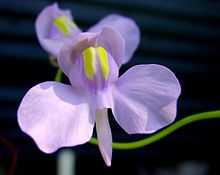Utricularia nelumbifolia
From Wikipedia, the free encyclopedia
| Utricularia nelumbifolia | |
|---|---|
 | |
| Scientific classification | |
| Kingdom: | Plantae |
| (unranked): | Angiosperms |
| (unranked): | Eudicots |
| (unranked): | Asterids |
| Order: | Lamiales |
| Family: | Lentibulariaceae |
| Genus: | Utricularia |
| Subgenus: | Utricularia |
| Section: | Orchidioides |
| Species: | U. nelumbifolia |
| Binomial name | |
| Utricularia nelumbifolia Gardner | |
| Synonyms | |
| |
Utricularia nelumbifolia is a large perennial aquatic carnivorous plant that belongs to the genus Utricularia. U. nelumbifolia, an epiphytic species, is endemic to Brazil. It was originally published and described by George Gardner in 1842. Its habitat is reported as being restricted to the water-filled leaf axils of Vriesia species, which are bromeliads, in arid volcanic locations at altitudes from 800 m (2,625 ft) to 2,200 m (7,200 ft). U. nelumbifolia will produce aerial stolons that descend into nearby leaf axils in order to colonize new territory, similar to the habit of U. humboldtii. It typically flowers from May to August.[1]
See also
References
| Wikimedia Commons has media related to Utricularia nelumbifolia. |
- ↑ Taylor, Peter. (1989). The genus Utricularia - a taxonomic monograph. Kew Bulletin Additional Series XIV: London.
This article is issued from Wikipedia. The text is available under the Creative Commons Attribution/Share Alike; additional terms may apply for the media files.